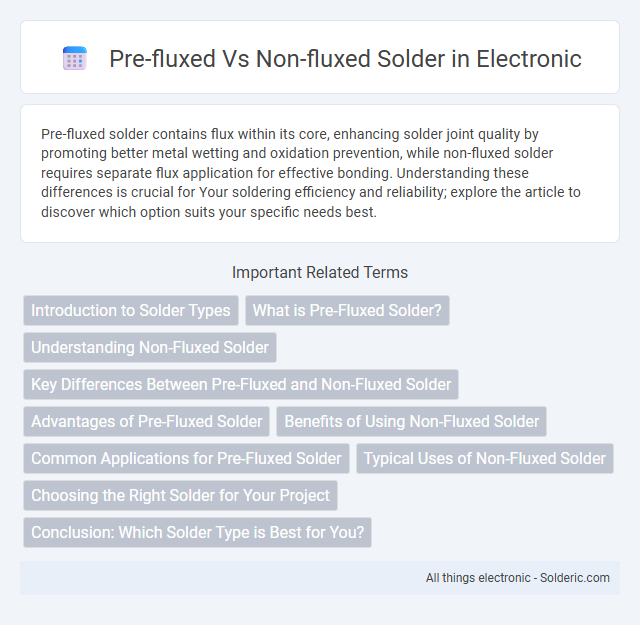Pre-fluxed solder contains flux within its core, enhancing solder joint quality by promoting better metal wetting and oxidation prevention, while non-fluxed solder requires separate flux application for effective bonding. Understanding these differences is crucial for Your soldering efficiency and reliability; explore the article to discover which option suits your specific needs best.
Comparison Table
| Feature | Pre-fluxed Solder | Non-fluxed Solder |
|---|---|---|
| Definition | Solder wire coated with flux core. | Solder wire without any flux core. |
| Flux Presence | Built-in flux core inside the wire. | No flux, requires external application. |
| Usage Convenience | Faster and easier soldering process. | Requires additional flux application step. |
| Oxidation Prevention | Flux eliminates oxides during soldering. | Higher risk of oxidation without flux. |
| Ideal For | Electronics, PCB assembly, and repairs. | Specialized soldering requiring custom flux. |
| Cost | Typically higher due to flux inclusion. | Generally lower base cost but may need extra flux. |
Introduction to Solder Types
Pre-fluxed solder contains flux within the solder core, promoting oxidation reduction and better wetting during the soldering process, essential for strong, reliable electrical connections. Non-fluxed solder requires external flux application, allowing precise control of flux amount and placement, ideal for delicate or intricate electronic assemblies. Choosing between pre-fluxed and non-fluxed solder depends on the specific soldering task, substrate materials, and desired process control.
What is Pre-Fluxed Solder?
Pre-fluxed solder contains a flux core integrated within the solder wire or pre-applied flux on solder preforms, which activates during the heating process to clean metal surfaces and improve bonding. This type of solder simplifies the soldering process by eliminating the need for separate flux application, making it ideal for precision electronics work. Using pre-fluxed solder helps you achieve cleaner joints, reduce soldering time, and minimize the risk of oxidation during assembly.
Understanding Non-Fluxed Solder
Non-fluxed solder lacks the chemical cleaning agents needed to remove oxides from metal surfaces, requiring you to apply flux separately to ensure proper adhesion and electrical conductivity. This type of solder is preferred for applications where precise control over flux application is necessary or when using highly sensitive components that might be damaged by flux residues. Understanding non-fluxed solder enables better preparation and handling during the soldering process to achieve strong, reliable joints.
Key Differences Between Pre-Fluxed and Non-Fluxed Solder
Pre-fluxed solder contains a built-in flux core that helps remove oxidation and improve wetting during the soldering process, ensuring stronger and cleaner joints without the need for additional flux application. Non-fluxed solder requires separate flux application to achieve proper adhesion and prevent oxidation, which can add extra steps and time to the soldering procedure. The choice between pre-fluxed and non-fluxed solder impacts convenience, solder joint quality, and overall process efficiency in electronics manufacturing and repair.
Advantages of Pre-Fluxed Solder
Pre-fluxed solder offers significant advantages such as simplified application by integrating flux directly into the solder, reducing the need for separate flux application and thus minimizing contamination risks. This type of solder promotes faster and cleaner solder joints, improving electrical conductivity and overall reliability in electronic assemblies. Using pre-fluxed solder can enhance your workflow efficiency by saving time and reducing the chance of soldering defects associated with improper flux use.
Benefits of Using Non-Fluxed Solder
Non-fluxed solder reduces the risk of residue contamination, making it ideal for sensitive electronic components where cleanliness is critical. It eliminates the need for post-soldering cleaning processes, saving time and reducing manufacturing costs. Using non-fluxed solder also minimizes potential corrosion and improves long-term reliability in electronic assemblies.
Common Applications for Pre-Fluxed Solder
Pre-fluxed solder is commonly used in electronics assembly, especially for surface mount devices (SMDs) where precise, clean solder joints are required without additional flux application. It finds applications in automotive electronics, consumer gadgets, and small-scale repairs due to its ease of use and reduced mess. Pre-fluxed solder also benefits automated soldering processes, improving throughput and consistency in mass production environments.
Typical Uses of Non-Fluxed Solder
Non-fluxed solder is typically used in applications where the surfaces are already clean or pre-treated to prevent oxidation, such as in electronic component assembly or plumbing with prepared joint surfaces. It is ideal for reflow soldering processes involving tightly controlled environments that minimize contamination and oxidation. Your projects benefit from non-fluxed solder when post-assembly cleaning is not feasible or when flux residues may cause corrosion or interfere with circuit performance.
Choosing the Right Solder for Your Project
Choosing between pre-fluxed and non-fluxed solder depends on project requirements and skill level; pre-fluxed solder contains flux core that simplifies the soldering process by cleaning and preparing metal surfaces during heating, making it ideal for beginners and small electronics repairs. Non-fluxed solder requires external flux application, offering greater control over flux use, reducing contamination risk, and is preferred in precision electronics or high-reliability projects. Selecting the appropriate solder ensures optimal joint strength, electrical conductivity, and long-term durability tailored to your specific soldering needs.
Conclusion: Which Solder Type is Best for You?
Choosing between pre-fluxed and non-fluxed solder depends on your project requirements and skill level; pre-fluxed solder simplifies the process by integrating flux, making it ideal for beginners and small electronics repairs, while non-fluxed solder offers greater control and purity, preferred in professional or high-precision applications. Pre-fluxed solder reduces cleaning time and provides consistent flux distribution, enhancing joint reliability in low-risk environments. Non-fluxed solder allows users to select and apply specific flux types tailored to complex tasks, ensuring optimal performance in demanding conditions.
Pre-fluxed vs non-fluxed solder Infographic

 solderic.com
solderic.com